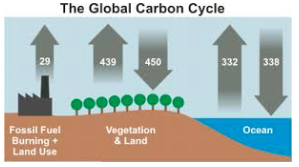This post is a bit off of my normal beat, but weather and how we understand it has a direct bearing on how we farm, now and in the future. The pic shows a comparison with vegetation and land being a net carbon sink. Agriculture has the capability to dramatically increasing carbon in the soil. I ran into these videos featuring:
David Icke on climate change - hoax (17:38), David Icke is, along with other professions, a professional conspiracy theorist. He comments on many issues around this juggernaut, "climate change", where I have reservations. This is a very controversial subject with the two sides being well entrenched. We are hammered, daily about our dependency on fossil fuels and being the cause of global climate change. This video led me to:
Climate Change Fact/Fiction? (47:32), by Atmospheric Physicist, Richard Lindzen at MIT. Richard Lindzen has been researching and writing opinions on climate change since 1961. Lindzen is a very low key presenter. In this forum he talks about temperatures, sea levels, CO2 emissions, the climate data, activists, political response. He doesn't see anything to be alarmed about.
David Icke on climate change - hoax (17:38), David Icke is, along with other professions, a professional conspiracy theorist. He comments on many issues around this juggernaut, "climate change", where I have reservations. This is a very controversial subject with the two sides being well entrenched. We are hammered, daily about our dependency on fossil fuels and being the cause of global climate change. This video led me to:
Climate Change Fact/Fiction? (47:32), by Atmospheric Physicist, Richard Lindzen at MIT. Richard Lindzen has been researching and writing opinions on climate change since 1961. Lindzen is a very low key presenter. In this forum he talks about temperatures, sea levels, CO2 emissions, the climate data, activists, political response. He doesn't see anything to be alarmed about.
"Climategate"(4:59), featuring Richard A Muller, Professor of Physics at University of California at Berkeley. This short presentation talks about climate data that a team of researchers falsified to stay in line with expectations. Another presentation I found interesting is one by Steven F. Hayward given in 2014.
A Funny Thing.....Climate Change (1:01:56) Hayward is a scholar at the Institute of Governmental Studies at UC Berkeley. He gives some background on how this phenomena developed into the political animal of today. One other presentation that I will list here is:
How To Green the Worlds Deserts (22:19), by a researcher of Biological Science, Allan Savory. This presentation explains that increasing desertification is playing a big part in warming the earth and causing Climate Change. Savory's presentation lines up well with information that I have been gathering for years, and is part of my interest in replacing chemical fallow or cultivated fallow with green fallow (cover crop).
---I believe in "climate change". Our world is dynamic. Climate is continuously transitioning.
---I do believe that humans have some influence on climate. I believe that normal farming practices of yesterday and today are a negative influence. Tillage, with every pass, releases CO2 and moisture to the atmosphere. This has been known for 40+ years, but early on it wasn't associated with climate change. Human activity is denuding the earth of plant material ranging from the destruction of tropical forests to us leaving land fallow. When vegetation is removed, the buffer is removed, so the earth warms. Add to this, population growth and associated expansion of urban areas and the infrastructure supporting that expansion. Allan Savory has a compelling story of concern, action and results from different land management practices.
---I do believe there are groups/organizations that influence societies behavior. I remember a quote by Senator Lyndon Johnson (before he became President Johnson), --"in politics there are no accidents. If something happens it is because someone wanted it to happen." Johnson was a very powerful, and manipulative Senator at the time. I don't remember the specific event that prompted this statement but it was my introduction to "power politics", and the ability to manage/manipulate public attitude. So, I do see a purposeful, one sided agenda here. The previous mentioned videos make mention of several underplayed factors. Fossil fuels are only a part of the perceived problem and probably a minor part. My post of March 17, 20017 titled CLIMATE CHANGE goes into much more detail on cycles and phenomena effecting the earth's climate where we have no control. Climate activists discount these cycles and events as insignificant. I think they don't fit the agenda.



